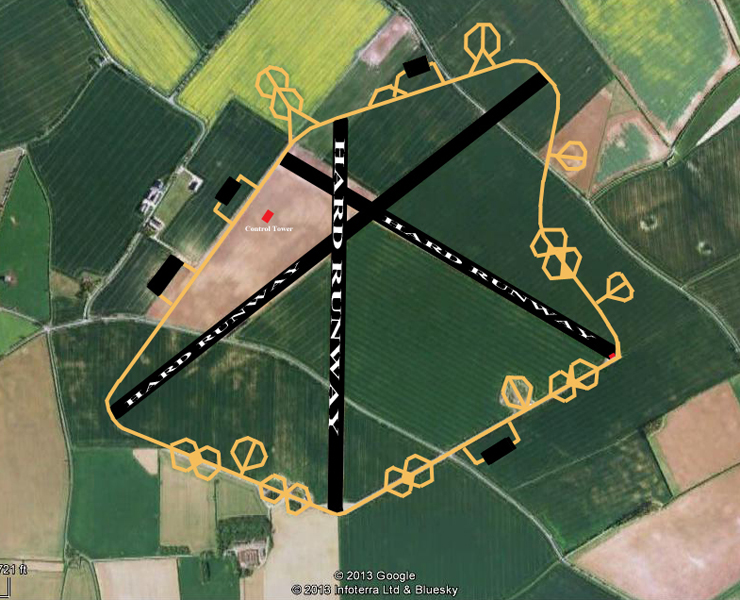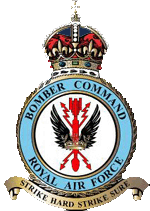Kelstern Airfield History

(Map edited to show the airfield and runways 1940-45)

© Crown Copyright/MOD 2010
53°24'42.59"N 0°06'12.26"WRunways:
01/19 & 13/31 4200ft x 150ft - 06/24 6000ft x 150ft
Military flying began at Kelstern as far back as 1916, but not at the location that was later to become RAF Kelstern. Back in December 1916 a small site near Mill Farm was taken over 0.6 miles NNW of the village and used as a Class 1 unlit landing ground by the RFC. The first and only residents were No.33 (Home Defence) Squadron operating a variety of aircraft including the Bristol Fighter and Avro 504. The squadron’s role while stationed here was the defence of North Lincolnshire from German Airships during the Great War. The landing ground covered an area of 90 acres by the end of the war, and had two landing strips, one of 700 yards and the other 650.
By June 1919 with the Great War now over, No.33 Squadron were to leave the landing ground, with the site soon being returned back to its original use as farmland.
Twenty three years later the RFC (now called the RAF), returned to Kelstern with the view to building an airfield as part of their expansion plan. But the original site of the Landing Ground was not chosen, instead a location just one mile to the NNE. The first examination of the new location took place on 13th February 1942, with a second one taking place on 2nd June the same year.
Work finally began on the airfield on 1st August 1942. The minor road from Binbrook to South Elkington running across the centre of the site was closed. Three intersecting concrete runways were the main 06-24 at 2000 yards and the subsidiaries, 01-19 and 13-31, both 1400 yards each. The 36 hardstandings were all the loop type. A T2 hangar was placed on the technical site on the north-west side of the airfield between the 13 and 06 runway heads, a second T2 between runway heads 01 and 31 and a third on the north side between 19 and 24. The bomb store was off the south-east side of the airfield, where the camp sites were dispersed in fields to the north-west. The buildings were largely the work of George Wimpey & Co Ltd and provided for 1585 males and 346 females.
On the 18th August 1943 the airfield was officially opened by Air Commodore Arthur “Hoppy” Wray. Also present at the opening was Group Captain R.H. Donkin who was to be the first commanding officer at RAF Kelstern.
The station was declared ready for operational use on 20th September 1943, and on the 1st October, No.625 Squadron was formed at the station as part of 1 Group, Bomber Command. With the formation of the new squadron came the stations first aircraft, the Avro Lancaster. The squadron was finally declared operational on the 9th October, and began a series of “Bullseye” navigational sorties around the country. The finally made its first operational sortie on the 18th , when nine Lancasters took part in a bombing raid on Hanover. The Squadron did not suffer it’s first loss until the night of the 3rd / 4th November, when one of the twelve aircraft taking part in an attack on Dusseldorf failed to return.
Lancasters from the station were to also take part in the Battle of Berlin. Their first lost during this operation was on the second raid on the German capital, on the 26th / 27th November. Avro Lancaster ED809, was shot down near Apeldoorn in Holland. Both the pilot, F/O R. McSorley and all his crew were sadly killed.
Despite all the losses in the various operational missions, the squadron did have some good luck. During a raid on Berlin, a Lancaster flown by Sgt Doyle was hit by another Lancasters incendiary bomb, damaging the rudder controls. But with the crews fast thinking, they carried out running repairs using an intercom lead and managed to make it back to the airfield.
June 1944 was to see No.625 Sqn set a new record (at the time) when it delivered 1202 tons of bombs to various targets in France as part of the run up to the Normandy invasion.

No.625 Sqn - Winter 1944 D-DOG
From left to right: Ken Hill (RAAF) MU, Don Balser (RCAF) BA,
Jim Boyle (RCAF) NAV, Jack Thornton (RAF) RG
© by kind permission of James H Boyle
By September 1944, No.625 Sqn had been expanded to three flights thus enabling the squadron to send 31 aircraft on the first of two 1000 bomber raids mounted in a single day against Duisburg. The squadron was to lose its first aircraft on the first raid only minutes after take-off. Lancaster LL956 (Q-Queenie) suffered engine problems on take-off, and with the aircraft fully loaded struggled to climb. The pilot F/O Hannah ordered his crew to jump while he attempted to avoid crashing in the small village of Fulstow. The aircraft finally came down in Little Grimsby. Only one of the crew was killed in this incident when his parachute failed to open after bailing out the aircraft.
The next residents at Kelstern were to be No.170 Squadron, which was reformed at the station using the nucleus of “C” Flight from No.625 Sqn, on the 15th October 1944. But their stay was short, and only a few days later on the 22nd the squadron left the airfield for RAF Dunholme Lodge. The day after their departure another “C” Flight was formed for No.625 Sqn.
Early 1945 saw the station selected for trials on how to house to incoming Avro Lincoln aircraft which was due to enter service later that year. The standard T2 hangars were to small, so a new way of manoeuvring the aircraft had to be found. The solution was to lay tram tracks taken up from nearby Grimsby and lay them across the apron and in to a hanger. A specially made trolley was placed on the tracks as to be able to manoeuvre the Lincoln in to the hangar sideways. A Lincoln prototype was specially flown in to test the system to which it passed with flying colours. But ironically after all this, it was not needed. The aircraft finally entered service in the summer of 1945, at a time when many of the airfields with the smaller hangars were being closed, so the system was never implemented at any other airfield.
The next major change at the station was to take place in April 1945. With Bomber Command being re-organised, No.625 Sqn was ordered to reduce in size to only two flights. The squadron was to make its final operational sortie of the war on the 25th April, taking part in a raid on Berchtesgaden. It’s final mission before VE day was to be a supplies drop to the Dutch in Rotterdam on the 7th May 1945.
With this reduction in size the squadron was left the airfield for RAF Scampton on the 5th April. It’s probable that the close proximity of other airfields and the risk of collisions through the overlapping circuits were behind this move, and thereafter no other flying units were based at Kelstern. In total 66 Lancasters failed to return or was lost in crashes during operations from the airfield.
With the end of the war, came the closure of the station. On 24th October the airfield became inactive and was then allocated to the Ministry of Agriculture. With this RAF Kelstern was formally closed on 4th August 1946. The country roads across the airfield which had been closed were reopened and eventually much of the concrete was broken up and removed. The hangars were sold and dismantled.

© BCAR - Looking down one of the former runways in 2013
The Ministry of Agriculture relinquished ownership of the airfield between 1965 and 1966. Selling off well over 900 acres to the various farmers that had been leasing the land from them.
Today very little of the once proud airfield remains. With the concrete runways slowly being removed to be used as hardcore, and the remainder being reclaimed for agricultural use.
As a reminder to the history of the airfield, the No.625 Squadron Association have erected a memorial on the corner of the old airfield. The memorial was dedicated on the 25th October 1964 as a tribute to all to have served their, and to those who never returned. A memorial service is held here every year by the remaining veteran’s and their families.
| Date | Squadron | Notes |
|---|---|---|
| Dec 1916 | RFC Landing Ground opens. | |
| Dec 1916 | No.33 Sqn | Operating the Royal Aircraft Factory BE.2 and FE.2, Avro 504 and Bristol Fighter. Left Kelstern on 19th June 1919. |
| July 1919 | RFC Landing Ground closed. | |
| August 1943 | Station opened on a new site 1 mile NNE of the RFC Landing Ground. | |
| October 1943 | No.625 Sqn | Squadron formed at the station. Operating the Avro Lancaster. Left Kelstern on 5th April 1945. |
| October 1944 | No.170 Sqn | Squadron formed at the station. Operating the Avro Lancaster. Left Kelstern on 22nd October 1944. |
| October 1945 | Flying ceased at the airfield. | |
| August 1946 | RAF Kelstern closed. | |
| 1965-66 | Station sold-off. |
